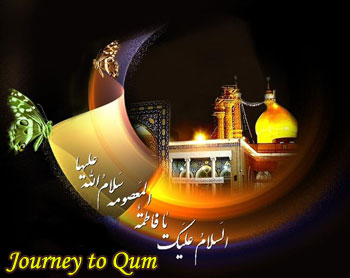.jpg)
Ziyārat (salutation) of Lady Fatima Masuma (A)
--------------------------------------------------------------------------------
السلام على آدم صفوة الله
Peace be on Adam, the Selected one of Allah.
السلام على نوح نبيّ الله
Peace be on Nūh, the Prophet of Allah.
السلام على ابراهيم خليل الله
Peace be on Ibrāhīm, the Friend of Allah.
السلام على موسى كليم الله
Peace be on Mūsā, who was Spoken with by Allah.
السلام على عيسى روح الله
Peace be on ` 4 sā, the Spirit of Allah.
السلام عليك يا رسول الله
Peace be on you, O Messenger of Allah.
السلام عليك يا خيرخلق الله
Peace be on you, O Best of Allah’s creatures.
السلام عليك يا صفى الله
Peace be on you, O Selected one of Allah.
السلام عليك يا محمّد بن عبد الله خاتم النّبيّين
Peace be on you, O Muhammad son of `Abdullāh, the Seal of the Prophets.
السلام عليك يا امير المؤمنين علي بن ابي طالب وصيّ رسول الله
Peace be on you, O Commander of the Faithful, Ali son of Abū Tālib, and the Successor of the Messenger of Allah.
السلام عليك يا فاطمة سيّدة نساء العالمين
Peace be on you, O Fatima, the leader of the women of the worlds.
السلام عليكما يا سبطى نبىّ الرّحمة وسيّدى شباب اهل الجنّة
Peace be on you, O the two grandsons of the Prophet of mercy, and the masters of the youth of Heaven.
السلام عليك يا علي بن الحسين سيّد العابدين وقرّة عينالنّاظرين
Peace be on you, O Ali son of Husain, the leader of worshippers, O tranquillity for those who gaze at you.
السلام عليك يا محمّد بن عليّ باقر العلم بعد النّبيّ
Peace be on you, O Muhammad son of Ali,
O revealer of knowledge after the Prophet.
السلام عليك يا جعفر بن محمّد الصّادق البارّ الأمين
Peace be on you, O Ja`far son of Muhammad,
the truthful, the righteous, the trusted.
السلام عليك يا موسى بن جعفر الطّاهر الطّهر
Peace be on you, O Mūsā son of Ja`far,
the pure, the purified.
السلام عليك يا على بن موسى الرّضا المرتضى
Peace be on you, O Ali son of Mūsā,
the pleased, the pleasing.
السلام عليك يا محمّد بن عليّ التّقيّ
Peace be on you, O Muhammad son of Ali,
the pious.
السلام عليك يا عليّ بن محمّد النّقيّ النّاصح الأمين
Peace be on you, O Ali son of Muhammad,
the pure, the benevolent, the trusted.
السلام عليك يا حسن بن عليّ
Peace be on Hasan son of Ali.
السلام على الوصيّ من بعده
Peace be on the successor after him.
اللّهمّ صلّ على نورك وسراجك ووليّ وليّك ووصيّ وصيّك وحجّتك علىخلقك
O Allah, Bless Your light and torch, the heir of your vicegerent, the successor of Your appointed successor and guide for mankind.
السلام عليك يا بنت رسول الله
Peace be on you, O daughter of
the Messenger of Allah!
السلام عليك يا بنت فاطمة وخديجة
Peace be on you, O daughter of
Fatima and Khadījah!
السلام عليك يا بنت امير المؤمنين
Peace be on you, O daughter of
the Commander of the Faithful!
السلام عليك يا بنت الحسن والحسين
Peace be on you, O daughter of
Hasan and Husain!
السلام عليك يا بنت وليّ الله
Peace be on you, O daughter of
the vicegerent of Allah!
السلام عليك يا أخت وليّ الله
Peace be on you, O sister of
the vicegerent of Allah!
السلام عليك يا عمّة وليّ الله
Peace be on you, O aunt of
the vicegerent of Allah!
السلام عليك يا بنت موسى بن جعفر
ورحمة الله وبركاته
Peace be on you, O daughter of
Mūsā son of Ja`far! May Allah shower
His mercy and blessings on you!
السلام عليك عرّف الله بيننا وبينكم فى الجنّة
Peace be on you.
May Allah grant us your companionship in Heaven,
وحشرنا فى زمرتكم
And put us in your group,
وأوردنا حوض نبيّكم
And lead us to your Prophet’s Fountain,
وسقانا بكأس جدّكم منّ يّد علىّ ابن ابى طالب صلوات الله عليكم
And quench our thirst out of your grandfather’s own cup, in the hand of Ali. May Allah bless you all!
أسأ ل الله أن ّيرينا فيكم السّرور والفرج
I ask Allah to grant us, through you,
happiness and ease,
وأن يجمعنا وإيّاكم فى زمرة جدّكم محمّد صلّى الله عليكم
And to brings us and you into the group of your grandfather, Muhammad. May Allah bless you all!
وأن لا يسلبنا معرفتكم إنّه وليّ قدير
And not to deprive us from understanding your status. Truly, He is the Guardian and is All-powerful.
أتقرّب إلى الله بحبّكم والبراءة من اعدائكم
I seek nearness to Allah through my love for you, and through my enmity for your enemies,
والتّسليم إلى الله راضيا به غير منكر ولا مستكبر
And I surrender to Allah willingly, neither denying nor being arrogant,
وعلى يقين ما أتى به محمّد وبه راض
And I accept with unshaken faith what was brought by Muhammad, and am content with that.
نطلب بذالك وجهك يا سيّدي اللّهمّ ورضاك والدّار الآخرة
We seek Your providence by this, O my Master! And Your pleasure in the next world, O my Lord!
يا فاطمة ٱشفعى لى فى الجنّة
فانّ لك عند الله شأناً مّنالشّأن
O Fatima ! Intercede for me, so that I enter Heaven,
for indeed you have a g reat status in the eyes of Allah!
اللّهمّ إنّى اسألك أن تختم لى بالسّعادة فلا تسلب منّي ما أنا فيه
O Allah, I ask You to make my destiny good,
and not to take away what I have [out of Your favour] at present.
لا حول ولا قوّة إلا بالله العليّ العظيم
There is no might or power save that oيةf Allah, the Exalted, the Great.
اللّهمّ استجب لنا وتقبّله بكرمك وعزّتك وبرحمتك وعافيتك
So by Your Generosity, Honour, Mercy and Bounteousness, accept our supplication.
وصلّى الله على محمّد وآله أجمعين وسلّم تسليماً يا أرحم الرّاحمين
And may the blessings of Allah shower on Muhammad and all his household and give them abundance and peace. O the most Merciful of the merciful!
من مؤؤسسة السبطين العالمية





تعليق